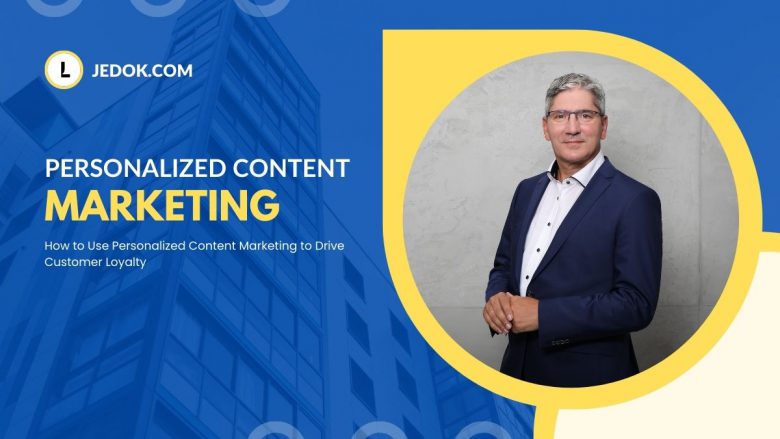
Personalized content marketing is a powerful strategy for driving customer loyalty. By tailoring your content to the interests and needs of individual customers, you can create a more engaging and relevant experience that fosters a sense of connection and loyalty. In this blog post, we’ll explore how businesses can use personalized content marketing to drive customer loyalty and provide some tips and best practices for implementing a successful personalized content marketing strategy.
1. Start with Customer Data
Personalized content marketing has become a buzzword in the digital age and for good reason. Consumers are bombarded with an overwhelming amount of information and advertisements every day, so it’s no surprise that they crave experiences that feel tailored to them personally. This is where customer data becomes crucial.
The first step in creating personalized content that drives customer loyalty is to collect and analyze customer data. This can include everything from basic demographic information to more detailed insights into individual preferences and behaviors. By understanding your customers on a deeper level, you can create content that speaks directly to their needs and interests.
But collecting customer data is just the beginning. To truly leverage this information, you need to analyze it effectively. Look for patterns and trends within your data sets to identify commonalities among your customers.
2. Create Content for Different Stages of the Customer Journey
As a business owner, it’s important to understand that not all customers are at the same stage of the buying journey. Some may be in the awareness stage where they are just learning about your brand and what you have to offer. Others may be in the consideration stage where they are comparing your products or services with those of your competitors. Lastly, some may be ready to make a purchase and are in the decision-making phase.
To effectively drive customer loyalty, it’s crucial to create personalized content for each stage of their journey. For example, if a potential customer is in the awareness stage, creating blog posts that educate them on industry trends or how-to guides related to your product can help build trust and establish your brand as an authority figure. Once they move into the consideration phase, providing case studies or product comparisons can aid in their decision-making process.
3. Use Personalization Tools and Technologies
In today’s world of marketing, personalization has become the key driver of customer loyalty and satisfaction. Personalized content marketing helps businesses connect with their customers at a deeper level by tailoring their messaging to meet individual needs and preferences. That’s why companies need to leverage personalization tools and technologies to make every interaction meaningful and relevant.
One way companies can use personalization tools is through email marketing campaigns. With advanced segmentation techniques, businesses can send targeted messages that resonate with specific groups of customers. For example, an e-commerce company could segment its customer base based on past purchase history or browsing behavior and send personalized recommendations accordingly. This not only increases the chances of conversion but also strengthens brand loyalty as customers feel understood and valued.
Another way to use personalization tools is through website optimization.
4. Encourage User-Generated Content
In today’s digital age, user-generated content has become a significant driving force for customer loyalty. Personalized content marketing is an effective strategy to encourage users to create and share their experiences with your brand. When customers feel connected to a brand through personalized content that speaks directly to them, they are more likely to become repeat buyers and advocates.
User-generated content provides social proof that your products or services are valuable and worthy of attention. It creates a sense of trust and authenticity as customers can see real people using and benefiting from your offerings. By encouraging user-generated content, you invite customers into the conversation around your brand, fostering a sense of community that goes beyond just making sales. This engagement can lead to increased customer satisfaction and loyalty as they feel valued by the brand for their contributions.
5. Measure and Optimize Your Strategy
Personalized content marketing is no longer a buzzword in the world of digital marketing. It has become the norm for businesses that want to drive customer loyalty and engagement. However, creating personalized content that resonates with your target audience is only half the battle. To truly make an impact, you need to measure and optimize your strategy constantly.
Measuring the success of your personalized content marketing effort involves tracking metrics such as website traffic, click-through rates, conversion rates, and social media engagement. These metrics help you understand which pieces of content are performing well and which ones need improvement. By analyzing this data regularly, you can identify trends and patterns that inform your future strategy.
Once you have a clear understanding of what’s working and what’s not, it’s time to optimize your strategy accordingly.
Conclusion
Personalized content marketing can be a powerful tool for driving customer loyalty. By starting with customer data, creating content for different stages of the customer journey, using personalization tools and technologies, encouraging user-generated content, and measuring and optimizing their strategy, businesses can create a more engaging and personalized experience that fosters loyalty and drives growth.



One Comment